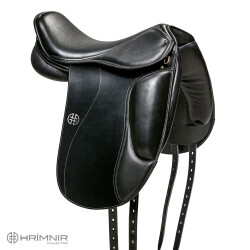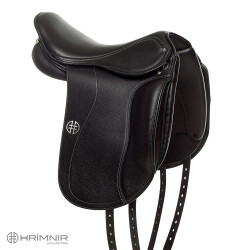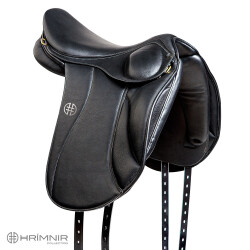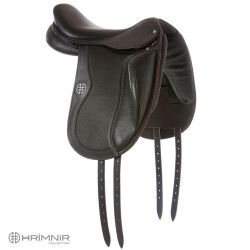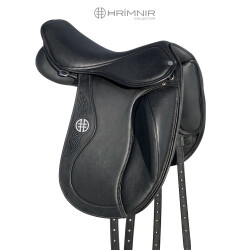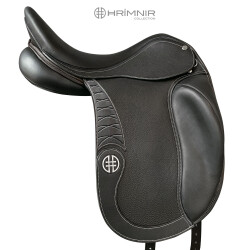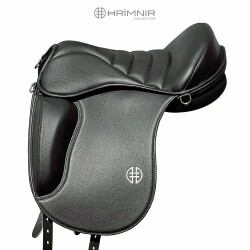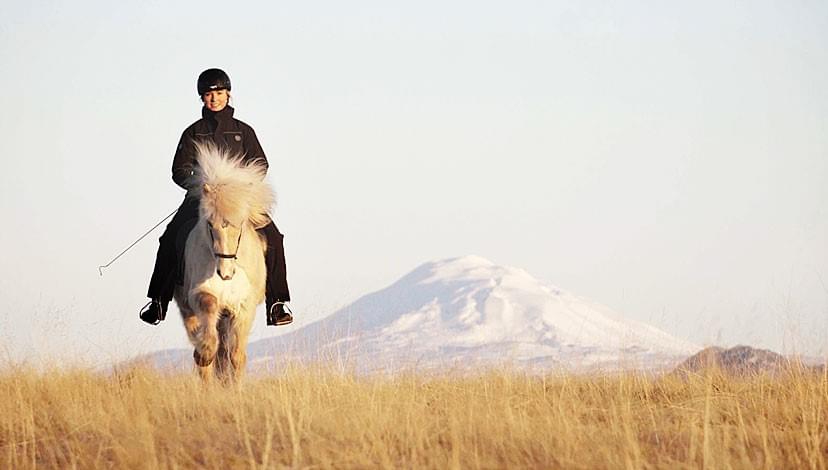High quality saddles for Icelandic horses
Saddle design
It requires a lot of knowledge and experience to design a good and well-fitting saddle. That's why our saddles are expertly designed by saddle makers, trainers, and veterinarians in close cooperation and undergo an extensive testing period.
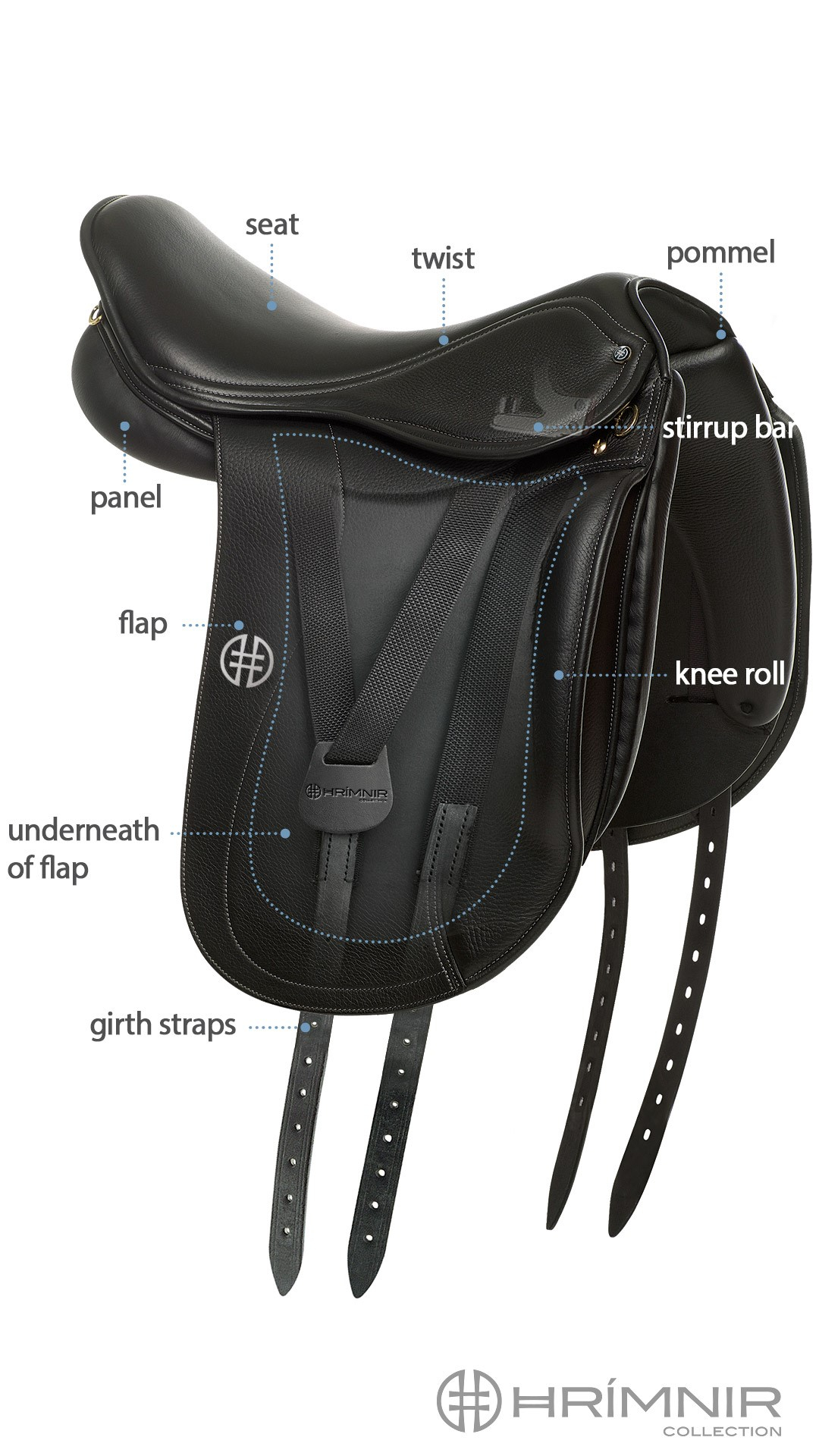
The design of the panels is crucial for a good saddle, as they provide the contact surface with the horse 's back. The panels in our saddles are broad and smooth, with ample gullet space for the horse 's spine in between in order to provide good comfort for the horse and give the spine and muscles in the horse 's back enough space to work freely and correctly. They are designed to adapt extremely well to the shape of the back and offer great fit. The surface of the panels is kept as wide as possible for optimal weight distribution.
The gullet (the channel between the panels on the saddle's underside) is the same width from back to front, but then it increases slightly at the withers. This allows the horse to move freely in front. If the saddle is too narrow over the withers, as many saddles for Icelandic horses are, it will pinch the back and neck muscles. Then those muscles cannot function properly and the horse will not be able to use its hindquarters correctly, resulting in shorter strides and less range of movement in the front legs as well as causing discomfort for the horse.
The twist (the narrowest part of the seat just behind the pommel) in our saddles allows the rider an extremely close contact with seat and legs for optimal communication with the horse and very accurate aids.
The seat is balanced correctly on the panels for even weight distribution on the horse 's back.
Balance, weight distribution, flexibility, and shock absorption are the defining qualities of a well-fitting, high quality saddle design.
A good saddle offers the right balance of strength and flexibility. It allows supple and round movements of the horse's back, because the saddle moves within itself from front to back and side to side. A good saddle allows natural movement in both horse and rider without losing its stability.
A good saddle enhances the balance of the rider, and it distributes the rider 's weight evenly on the horse 's back. The design of the seat and knee pads is such that it helps the rider sit in balance and relaxed. Good balance is the key to success. The saddle tree and the panels are the most important factors for good balance and weight distribution.
The saddle tree
A good saddle tree is designed to position the rider near the centre of the saddle for even weight distribution. It also offers flexibility for good rider performance.
The same philosophy applies to horses and saddles: you can have horses with great conformation and talent, but if their movements aren't flexible and elastic, they don 't perform well. If the saddle tree (the core of the saddle) is not flexible, the saddle cannot function correctly. That 's why we have chosen to use DuPont® Flex saddle tree that features the XChange® gullet plate system in our saddles.
The DuPont® saddle tree is one of the most technically advanced spring saddle trees in the world. It follows the movements of the horse especially well. This saddle tree is designed to position the rider near the centre of the saddle for even weight distribution across the panels. The Dupont® saddle tree offers enormous flexibility together with stability and strength, providing better balance for rider and horse. The saddle tree is molded with specially designed polymers by Dupont®. The tree has an interchangeable steel gullet plate, which can be taken out easily and replaced with a narrower or wider piece. Temperature changes don't affect the tree's structure, and the material offers exceptional flexibility and resistance. This combination of qualities allows extraordinary contact between rider and horse by adjusting to different horses' backs, riding styles, and positions of the rider.
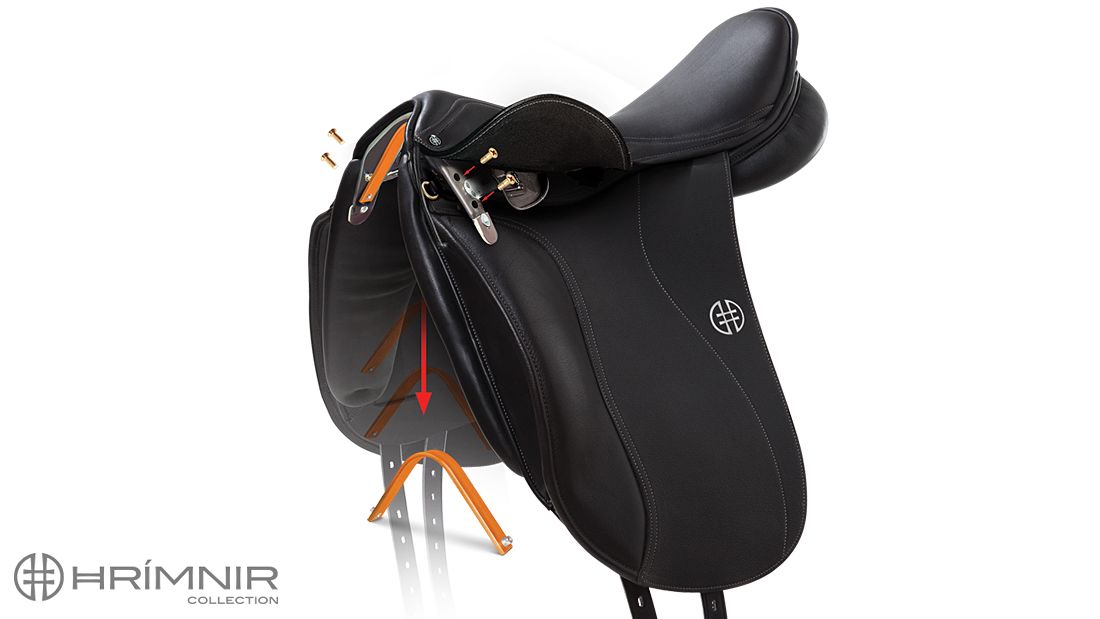
The XChange® gullet plate system
The XChange® gullet plate system is a revolutionary system that allows the tree width to be modified to the withers and back of any horse, or as the horse grows and changes. By adjusting the Xchange® gullet individually, pressure points in the front part of the horse 's back are avoided and the weight distribution of the saddle is optimized.
Saddles without changeable gullet plate systems can be widened by a saddle maker (usually not recommended for more than one size), but never narrowed.
The panels
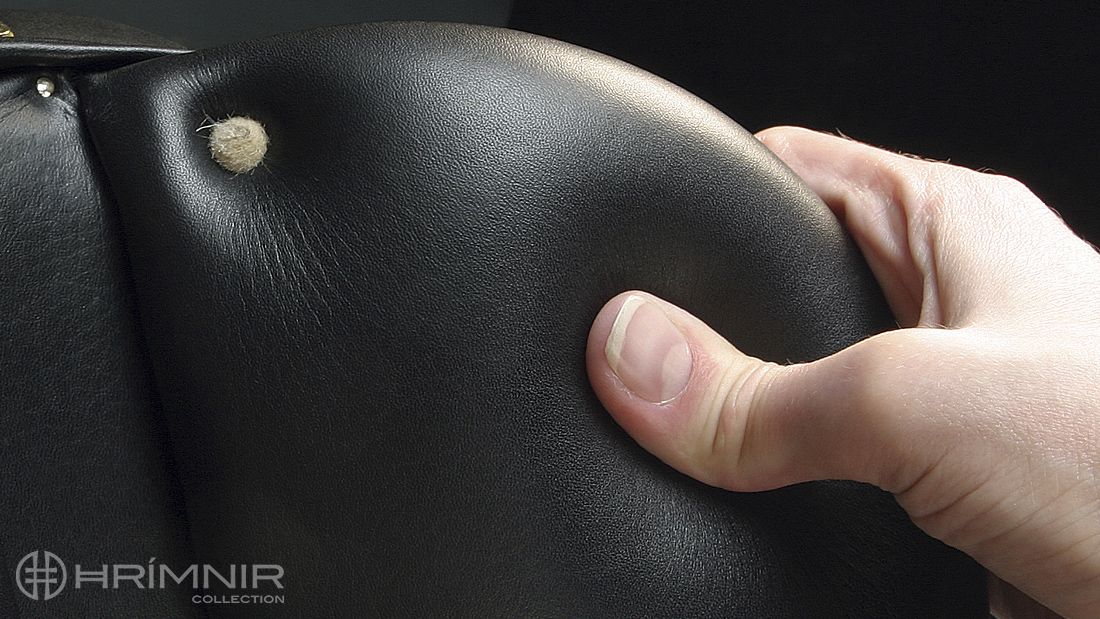
The panels of a good saddle provide a cushion for the horse 's back and distribute weight well and evenly, but retain their shape. Good panels allow very close but soft contact, adjust well to various horses, and are symmetrical. The filling of the panels plays an important role. Read more about the BayFlex® filling and the AMS® synthetic wool panels used in Hrímnir saddles.
Bear in mind that shorter panels offer a smaller area of support, which might be disadvantageous for heavier riders. The panels should always be designed to match the centre of the saddle for correct distribution of pressure.
Bayflex foam
Most of our saddle panels are filled with Bayflex® foam. It offers maximum comfort, flexibility, and memory, and results in extraordinary support and balance of the saddle. The material adapts to the shape of both rider and horse, allowing more precise aids and free movement of the horse. Bayflex® is used by World Champions every day in their training. On the market for several years and being used during millions of riding sessions, the result has been nothing but exceptional.
The BayFlex® material allows the panels to be pre-formed, but they adapt to the horse 's shape during riding. The panels are shaped for close but soft contact, and even weight distribution. They provide the rider as much contact with the horse as possible, leading to better balance.
As the panel is essentially a cushion, we chose the Bayflex® material 's degree of softness to provide perfect cushioning, while still holding its shape well. Since BayFlex® always retains its shape and stays soft, the panels stay symmetrical and comfortable for the horse and the seat always stays soft for the rider.
The combination of BayFlex® and the DuPont® saddle tree allows the saddle to follow the movements of the horse especially well. This results in close contact and high comfort for both horse and rider.
Bayflex® is a polyurethane foam made from rubber trees that is the world 's most popular mattress material. This open cell foam allows excellent airflow through the material. Bayflex® is an extremely versatile material that can adjust itself to different pressures and maintain its protection without losing its shape. It is able to provide ultimate cushioning without bulk.
Bayflex® is formed with an injection molding process which guarantees that every piece is exactly the same. Since the fittings for the assembly of the panels are part of the mold of the saddle tree, the position of the panels is also exactly the same in every saddle. This manufacturing process prevents even a minimal crookedness that can appear in saddles that are put together manually. We can be 100% sure that all our saddles have the same shape and are completely symmetrical.
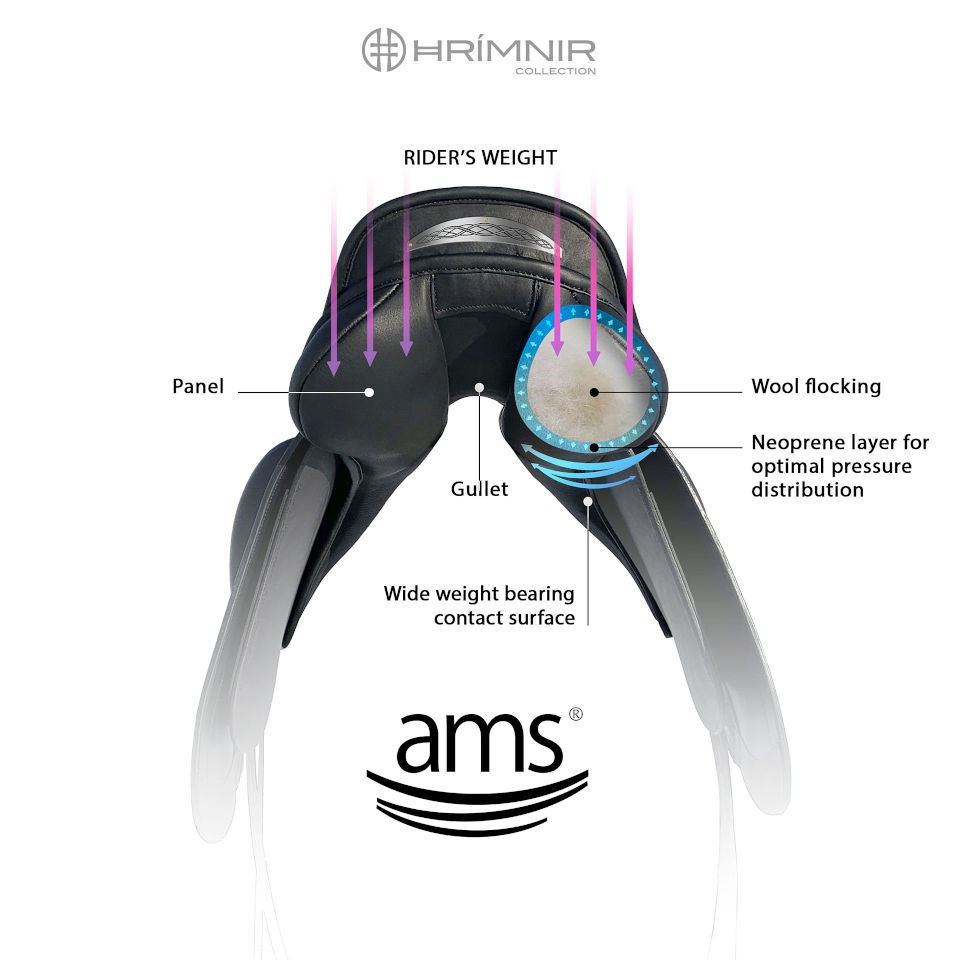
AMS® synthetic wool panels:
Traditional saddles with a conventional wool or wool/synthetic mix filling need about six months of regular riding to settle into the shape of the horse's back and at this time the first re-stuffing is already required. This is because wool does not go back to its original shape and the panels can become asymmetrical or develop hardened bulky spots, as the filling shifts or bunches together. This can cause soreness for the horse.
Regular check-ups then follow, to make sure that the weight of the rider or possible crookedness of the rider or horse did not shape the filling in an undesirable way.
The AMS® technology was developed to reduce these negative characteristics of a conventional wool filling and combine it with the unique properties of wool, which provides good shock absorbing and a good universal fit on different horses as well as a soft and kind contact to the horse 's back, that allows a good connection between the horse and the rider.
The patented AMS® panel technology features an exterior neoprene layer at the inside of the panel, which is designed to stabilise pressure and disperse variances in pressure within the panels in order to avoid hotspots. This provides a soft and consistent contact on the horse 's back that distributes pressure evenly and features great shock absorbing properties. This allows maximum comfort and freedom of movement for the horse and encourages it to lift and use its back more effectively, while providing the rider with good support and a smoother, shock absorbing ride.
Neoprene was chosen due to its breathability, shock attenuation and durability. The neoprene layer also has a big advantage, in that it adapts distinctively well to the horse 's back and provides a soft and even layer that distributes the rider 's weight very effectively.
The synthetic high-quality wool provides good resilience under different weather and temperature conditions, ruling out the development of mould or mildew.
Saddles that feature AMS® panels can be re-stuffed and fitted individually to the shape of your horse 's back, just as every traditional saddle with conventional wool filling.
Billet system and balance strap
The billet system in Hrímnir saddles increases the stability of the saddle. All saddles are fitted with two billet straps on either side. The front billet strap is connected to the front part of the saddle tree and will hold the saddle steady. The rear billet strap is attached to a V-shaped balance strap. This system prevents the saddle from bouncing up and down, as well as swinging from side to side and sliding forward.
The Hrímnir saddles Pro, Master and Champion additionally feature a ring at the V-shaped billet system for an optional girth strap that can be easily attached to the saddle and removed again. Some riders want increased stability of the saddle, and this provides an option to attach an additional single girth in front of the regular girth.
Quality
Leather
Saddle leather should be soft and supple, not stiff and hard. The old adage applies: "You get what you pay for". Price is not always the only indication of quality, so these points help judge whether or not you will get your money's worth:
The most durable leather dyes are "drum-dyed" in a type of washing machine action, completely bathing the hide. The dye easily comes off "spray-painted" hides which are common in cheap saddles.
You will know which method was used by bending a piece of leather and looking whether the fibers are dyed all the way through.
Quality control
Before our saddles leave the manufacturer, they go through strict quality inspection. The saddles are carefully inspected by a qualified saddle maker for the following:
- Symmetry. We make sure that the saddle is not twisted, and all parts are even.
- All seams are properly finished.
- Fittings and finish are correct.
Warranty
We offer a 25-year warranty on the saddle-tree against breaking, and the XChange® gullet system.
We offer a 2-year warranty on the whole saddle with normal usage (riding up to 6 horses per day), being regularly and sufficiently cleaned and oiled.
The final quality control guarantees that our saddles are free of any construction defects. A minor cosmetic defect that has no effect on the performance of the saddle is not covered.
Every saddle needs proper care, handling, and storage. Read more about correct saddle care.
Saddle care
Before first use
We recommend oiling your new saddle before first use with a high-quality leather oil.
To avoid rubbing the finish off or scratching the grain of the leather of a new saddle, do not ride in the saddle until it has been properly oiled.
The purpose of oiling the saddle before use is for comfort and prevention of wear and tear, rather than to achieve a deeper coloration.
With a soft brush or a sponge, generously spread a thin coat of warm (not hot) leather oil over all parts of the saddle, top and bottom. Don 't forget the billets and billet guard. However, do not soak the seat, kneepads, panels and billets with oil. Let the oil penetrate for 24 hours, leaving the saddle in a dry place. Then carefully remove the excess oil by buffing with a soft cloth. Do not forget to lightly oil your stirrup leathers, because dry stirrup leathers are very abrasive and might damage the grain of the saddle leather.
Protect your investment
We purposely chose to use only natural leather for our saddles. We rejected a chemical process that turns leather more resistant against environmental influences because it also makes it harder and stiff. Instead, we chose eco-friendly, naturally processed leather to achieve unique softness, flexibility, high comfort, and an elegant look. We care about that naturally processed leather is better for the environment and your health. However, natural leather requires good care and correct use in order to remain at its best. Even high-quality leather needs regular cleaning and care to keep it soft, and to protect it from environmental damage.
Exposure to water, dirt, sweat, or a lot of sunshine puts extra stress on leather and makes it dry, brittle, and pale. All our riding equipment is made of the finest leather, and we highly recommend cleaning and oiling it regularly, and especially after exposure to environmental damage. The more extreme the situation of your ride, the better care you need to take of your riding equipment. Your high-quality leather tack will not stay soft and rich in colour without proper care and use.
We recommend daily cleaning of your leather tack with glycerine saddle soap and a damp sponge. Additionally, a thin layer of high-quality leather oil should be applied from time to time. The frequency and quantity of leather oil depends on the use and environmental damage to the tack. Protect your investment by making sure the leather stays soft and rich in colour. You should only use a small amount of leather oil on pieces or straps that are load bearing, for example stirrup leathers or reins.
Correct storage and handling
The storage of your saddle will greatly influence its condition. We recommend storing your saddle under the saddle cover on a supportive saddle rack instead of a single pole. The girth should lie across the saddle and not hang attached to the billets on one side. The saddle should be kept in a dark and dry room or saddle closet where it is not exposed to sunlight or other environmental damage. If the saddle becomes wet during use, it should always be dried off with a soft towel before storage in order to avoid water stains.
Avoid putting your saddle on the floor, even for short storage, and always use a saddle cover when travelling with your saddle.
Helpful information
Try out our online Saddle Expert that gives you free online saddle guidance and helps you find the right saddle for you and your horse.
We also have experienced saddle fitters in our team in different countries. Please contact them if you would like advice on saddle fitting near your hometown.
For testing and choosing a Hrímnir saddle, please contact the next Hrímnir dealer closest to you. He will assist you in choosing the saddle that suits your and your horse’s needs best and ensure correct saddle fit.
Check out our other saddle equipment. There you can shop the Xchange Head Gullets to fit the saddle tree width individually to your horse and you can also find high-quality saddle pads and girths, that can help to improve the fit of your saddle furthermore and provide the horse with extra comfort. You can also find care products such as leather oil and leather soap to take good care of your saddle and protect it and other riding equipment from environmental damage. You will also find additional equipment such as stirrups, stirrup leathers and saddle covers.
































